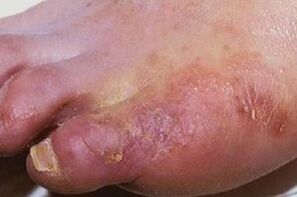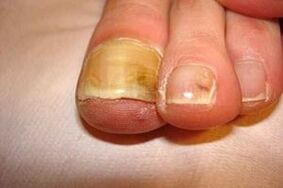Not everyone knows what toenail fungus looks like and can initially identify this disease and begin treatment. Itching, redness of the skin, peeling, and cracking are signs of this condition. However, there are other diseases with similar symptoms, such as eczema or psoriasis. And even toenails can change their appearance not due to a fungal infection, but due to psychological stress or a number of diseases of the internal organs. Therefore, the final diagnosis can only be made by a doctor after receiving the test results. And the task of the patient is to consult a doctor in time if warning signs appear.

The main symptoms of mycoses.
The characteristic symptoms of mycosis of the feet are desquamation and, more frequently, of a certain shape in the form of rings or plaques. Sometimes it is so insignificant that such a situation can last for many months, if not years, and at the same time not even cause much discomfort. At the same time, some people try to fight these manifestations of mycosis on their own. They use home remedies like iodine, vinegar, and bright green, and for a while the disease really goes away. More precisely, it seems so, but in fact this treatment leads to the fact that the fungus on the legs simply freezes, and then continues to multiply when a more favorable situation occurs.
Also, if at an early stage such a disease is not completely cured, but only the symptoms are eliminated, then very soon it will spread to the nail and smooth skin. Not to mention, other family members can get the fungal disease.

The degree of injury in mycosis of the feet depends on many factors. If there are prerequisites such as microtrauma, various pathologies of the endocrine system, diabetes mellitus, if a person undergoes a certain treatment with glucocorticoids or cytostatics, all this contributes to the further development of the disease.
Someday the period of relative stability ends, and the patient does not see the most attractive picture - this is not only peeling of the skin, but also bubbles, cracks on the foot, suppuration. All of these are classic symptoms that are present in the later stages of the development of the pathology. At the same time, the initial stage of nail fungus is visible. Although the type of microorganisms can be examined in more detail only under a microscope, their activity is much more noticeable - this is a change in the shape and color of the nails, then their thickening and destruction.
Nail fungus and its manifestations.
Toenail flexibility manifests itself in different ways. It all depends on the stage of the disease and what type of fungus is the cause. Normally, the nail should be smooth, pink, and even shiny. If the condition of the nails is far from the described ideal, then something is happening to the body.
Nails grow at a certain speed. When a person is under stress, this rate decreases and the nail becomes thinner and weaker. Then the body returns to normal and the nails return to their original state from the point of growth indicators, but this weak strip on the nail plate still remains. And if a person's life is quite nervous, then there may be several such stripes. Also, onychomycosis (and this is the scientific name for nail fungus) is not the only disease that causes a change in the color of the nail plate or its shape. Pathologies such as immune failure, hormonal imbalances, and other endocrine system disorders lead to exactly the same results. That is why a case-by-case analysis is necessary.
The appearance of the fungus largely depends on which microorganisms caused the onychomycosis. And it can be triggered by various types. For example, if we talk about dermatophytes, the fungus looks like a clouding of the nail. This is a manifestation of the initial stage of toenail fungus. After that, yellow spots may appear along the edge of the plate and even in the middle. Then longitudinal stripes appear, and the nail begins to collapse.
Otherwise, problems caused by yeast appear. In such cases, the nail plate becomes noticeably thinner, acquires a grayish tint, and after a while it already deviates from its normal position. This is largely due to the fact that metabolism deteriorates in injured cells. At the same time, the grooves that appeared in the nail fold finally confirm the diagnosis - yeast fungi.
Mold must be mentioned separately. Usually it affects only the nail plate, causing it to become cloudy and discolored; It can be light yellow, greenish, brown, and even black.
The peculiarity of these fungi is that they only cause superficial damage and do not penetrate deep inside.
It is clear that the diagnosis can only be made by the attending physician, who will consider all the symptoms and perform the tests. Self-treatment without going to the doctor is fraught with very unpleasant consequences.
Stages and types of onychomycosis

Taking into account the stages of onychomycosis, many confuse them with the varieties of this disease, of which there are three. This is normotrophic, hypertrophic, and atrophic onychomycosis.
For example, with normotrophic onychomycosis, the color of the nail changes, streaks and spots may appear, but its thickness and gloss remain normal. Many people think that it is a nail fungus, the initial stage of which is about to turn into a more serious pathology, but in fact the fungus in such situations responds well to treatment.
With hypotrophic onychomycosis, the color of the nail changes, its shine is lost, the nail itself thickens and its deformation occurs, in some cases even destruction along the edges. The onycholithic species is often called atrophic. This is not the same toenail fungus, the initial stage of which is expressed in cracks and discoloration, here the treatment will be different, since the affected part of the plaque atrophies.
Treatment of mycosis of feet and nails.
The first thing to do with this disease is to consult a doctor who will help you choose a drug that meets the following requirements:
- high antifungal activity, which allows you to fight different types of infectious agents;
- a sufficiently high concentration of the active substance both in the preparation and in the surface layers of the skin after its application;
- antifungal and antibacterial complex therapy;
- without contraindications and side effects, including allergic reactions;
- Easy to use.
Given these demands, it is not surprising that the drug selection stage is so important. As a rule, in the absence of complications, drugs based on substances such as ciclopirox and naftifine are used. They are produced in the form of ointments, less often in the form of tablets. In a more severe stage of mycosis, it is recommended to treat it with medications based on terbinafine and fluconazole.
Tablets should be taken if ointments and creams for external use did not work. The dosage of the tablets should be verified with the attending physician. As a general rule, these are all quite strong remedies, so the course of treatment is about 7-10 days, although there are drugs that can be taken even for 3-4 weeks.
The attending physician prescribes such therapy, taking into account what other medications the patient will take. These medications can have the side effect of vomiting or dizziness. This is considered valid. Generic drugs are milder than the originals, but the effect of them is small.
Operational interventions
Previously, in advanced cases, surgical removal of the affected tissue was practiced. This was especially true of the nails. Now they use a drill like the one used in dental offices. Even in the most advanced cases, cutting almost all nails will take about half an hour. And if the problem is only in one affected nail, it will only take about 5 minutes.

You do not need to take extra precautions after the procedure. This procedure does not cause any painful sensations, you can lead a regular lifestyle, morning jogging. It is only important to make sure that the affected areas of the skin are not injured.
A nail treatment with such a preparation is not enough, anyway, it will need to be repeated at least once more, 3-4 weeks after the first treatment, when the nails grow a little. In general, you should be aware of the fact that this process is long, it can take a month, and if things have gone far enough, several months. For example, there are cases when for the first 3-4 months a patient performs a nail treatment with such a tool every 2-3 weeks, and then takes medication for several months.
Are home remedies effective?
Any doctor will say that the recipes of traditional medicine for such a disease are ineffective and even harmful. First of all, neither vinegar, nor herbs, not even honey, despite their antiseptic agents, practically do not affect the fungus. Yes, you can hear from your friends that some of these recipes helped get rid of the itch or cracks. Well, then these signs were simply not attributed to the fungus. The same psoriasis or eczema have similar symptoms and are perfectly treated with the above folk methods.
Second, these drugs help to eliminate the signs of the fungus, that is, they mask it for a while, and this is enough for all members of the family to become infected.
However, the vinegar mentioned above will be effective for other purposes: it can be used to wash bedding and shoes to prevent re-infestation of the fungus. The only shoes that are not washed but thrown away are house slippers, because they cannot be disinfected. Vinegar can also be used to disinfect the bathtub.





























